2004 ISUZU TF SERIES fuel
[x] Cancel search: fuelPage 1765 of 4264
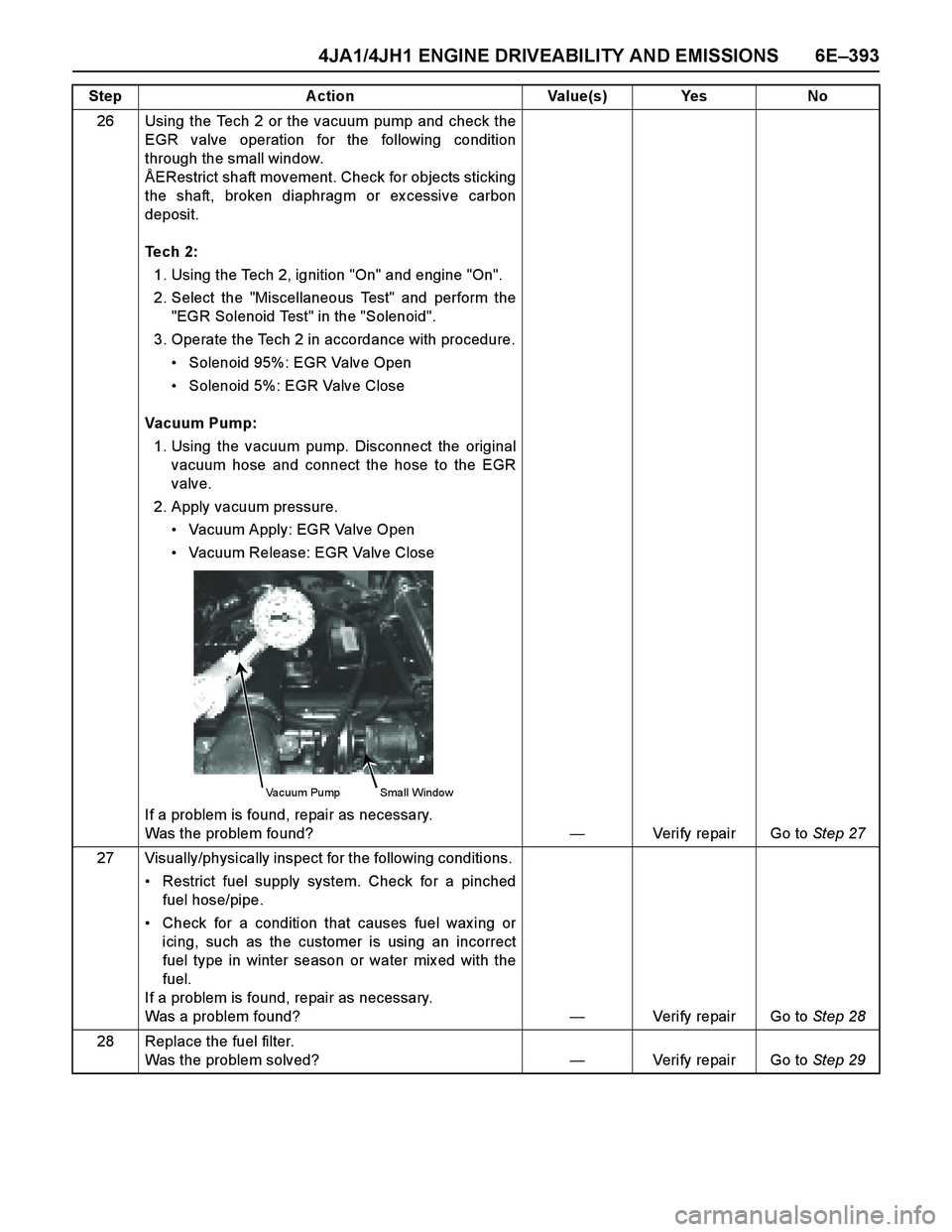
4JA1/4JH1 ENGINE DRIVEABILITY AND EMISSIONS 6E–393
26 Using the Tech 2 or the vacuum pump and check the
EGR valve operation for the following condition
through the small window.
ÅERestrict shaft movement. Check for objects sticking
the shaft, broken diaphragm or ex cessive carbon
deposit.
Tech 2:
1. Using the Tech 2, ignition "On" and engine "On".
2. Select the "Miscellaneous Test" and perform the
"EGR Solenoid Test" in the "Solenoid".
3. Operate the Tech 2 in accordance with procedure.
Solenoid 95%: EGR Valve Open
Solenoid 5%: EGR Valve Close
Vacuum Pump:
1. Using the vacuum pump. Disconnect the original
vacuum hose and connect the hose to the EGR
valve.
2. Apply vacuum pressure.
Vacuum Apply: EGR Valve Open
Vacuum Release: EGR Valve Close
If a problem is found, repair as necessary.
Was the problem found?—Verify repair Go to Step 27
27 Visually/physically inspect for the following conditions.
Restrict fuel supply system. Check for a pinched
fuel hose/pipe.
Check for a condition that causes fuel wax ing or
icing, such as the customer is using an incorrect
fuel type in winter season or water mix ed with the
fuel.
If a problem is found, repair as necessary.
Was a problem found?—Verify repair Go to Step 28
28 Replace the fuel filter.
Was the problem solved?—Verify repair Go to Step 29 Step Action Value(s) Yes No
Vacuum Pump Small Window
Page 1766 of 4264
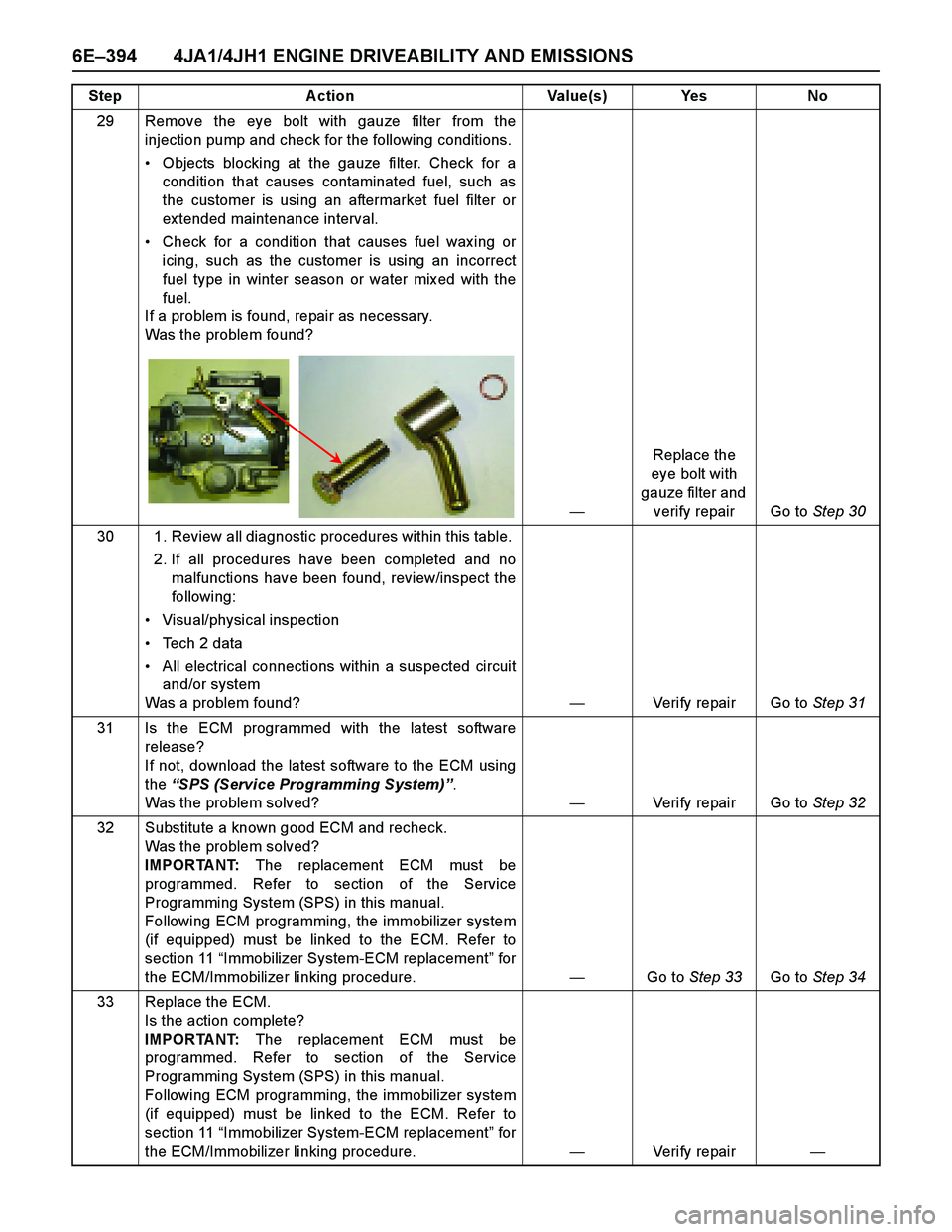
6E–394 4JA1/4JH1 ENGINE DRIVEABILITY AND EMISSIONS
29 Remove the eye bolt with gauze filter from the
injection pump and check for the following conditions.
Objects blocking at the gauze filter. Check for a
condition that causes contaminated fuel, such as
the customer is using an aftermarket fuel filter or
ex tended maintenance interval.
Check for a condition that causes fuel wax ing or
icing, such as the customer is using an incorrect
fuel type in winter season or water mix ed with the
fuel.
If a problem is found, repair as necessary.
Was the problem found?
—Replace the
eye bolt with
gauze filter and
verify repair Go to Step 30
30 1. Review all diagnostic procedures within this table.
2. If all procedures have been completed and no
malfunctions have been found, review/inspect the
followi ng:
Visual/physical inspection
Tech 2 data
All electrical connections within a suspected circuit
and/or system
Was a problem found?—Verify repair Go to Step 31
31 Is the ECM programmed with the latest software
release?
If not, download the latest software to the ECM using
the “SPS (Service Programming System)”.
Was the problem solved?—Verify repair Go to Step 32
32 Substitute a known good ECM and recheck.
Was the problem solved?
IMPORTANT: The replacement ECM must be
programmed. Refer to section of the Service
Programming System (SPS) in this manual.
Following ECM programming, the immobilizer system
(if equipped) must be linked to the ECM. Refer to
section 11 “Immobilizer System-ECM replacement” for
the ECM/Immobilizer linking procedure. —Go to Step 33Go to Step 34
33 Replace the ECM.
Is the action complete?
IMPORTANT: The replacement ECM must be
programmed. Refer to section of the Service
Programming System (SPS) in this manual.
Following ECM programming, the immobilizer system
(if equipped) must be linked to the ECM. Refer to
section 11 “Immobilizer System-ECM replacement” for
the ECM/Immobilizer linking procedure.—Veri fy repai r— Step Action Value(s) Yes No
Page 1768 of 4264
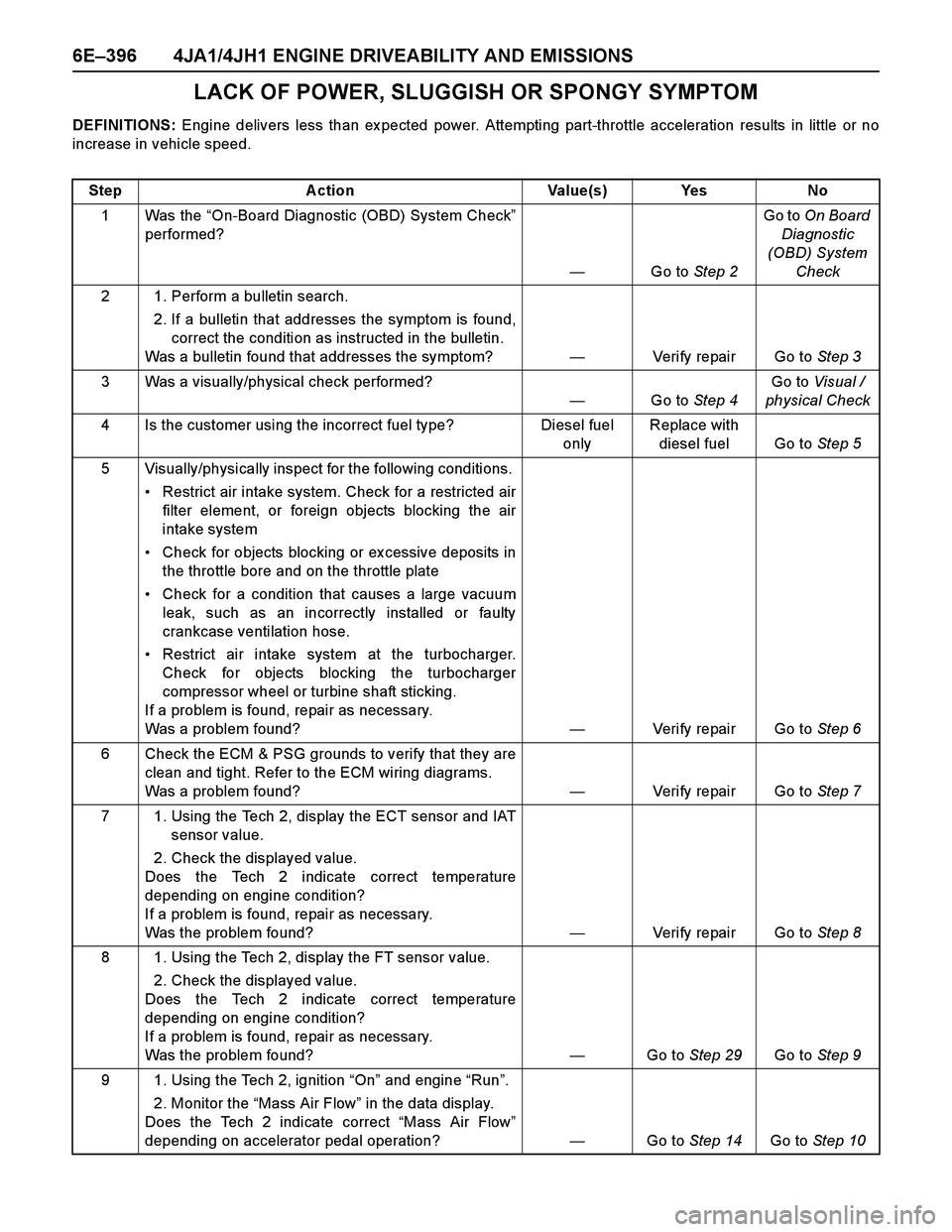
6E–396 4JA1/4JH1 ENGINE DRIVEABILITY AND EMISSIONS
LACK OF POWER, SLUGGISH OR SPONGY SYMPTOM
DEFINITIONS: Engine delivers less than ex pected power. Attempting part-throttle acceleration results in little or no
increase in vehicle speed.
Step Action Value(s) Yes No
1Was the “On-Board Diagnostic (OBD) System Check”
performed?
—Go to Step 2Go to On Board
Diagnostic
(OBD) System
Check
2 1. Perform a bulletin search.
2. If a bulletin that addresses the symptom is found,
correct the condition as instructed in the bulletin.
Was a bulletin found that addresses the symptom?—Verify repair Go to Step 3
3 Was a visually/physical check performed?
—Go to Step 4Go to Visual /
physical Check
4 Is the customer using the incorrect fuel type? Diesel fuel
onlyReplace with
diesel fuel Go to Step 5
5 Visually/physically inspect for the following conditions.
Restrict air intake system. Check for a restricted air
filter element, or foreign objects blocking the air
intake system
Check for objects blocking or ex cessive deposits in
the throttle bore and on the throttle plate
Check for a condition that causes a large vacuum
leak, such as an incorrectly installed or faulty
crankcase ventilation hose.
Restrict air intake system at the turbocharger.
Check for objects blocking the turbocharger
compressor wheel or turbine shaft sticking.
If a problem is found, repair as necessary.
Was a problem found?—Verify repair Go to Step 6
6 Check the ECM & PSG grounds to verify that they are
clean and tight. Refer to the ECM wiring diagrams.
Was a problem found?—Verify repair Go to Step 7
7 1. Using the Tech 2, display the ECT sensor and IAT
sensor value.
2. Check the displayed value.
Does the Tech 2 indicate correct temperature
depending on engine condition?
If a problem is found, repair as necessary.
Was the problem found?—Verify repair Go to Step 8
8 1. Using the Tech 2, display the FT sensor value.
2. Check the displayed value.
Does the Tech 2 indicate correct temperature
depending on engine condition?
If a problem is found, repair as necessary.
Was the problem found?—Go to Step 29Go to Step 9
9 1. Using the Tech 2, ignition “On” and engine “Run”.
2. Monitor the “Mass Air Flow” in the data display.
Does the Tech 2 indicate correct “Mass Air Flow”
depending on accelerator pedal operation? —Go to Step 14Go to Step 10
Page 1771 of 4264
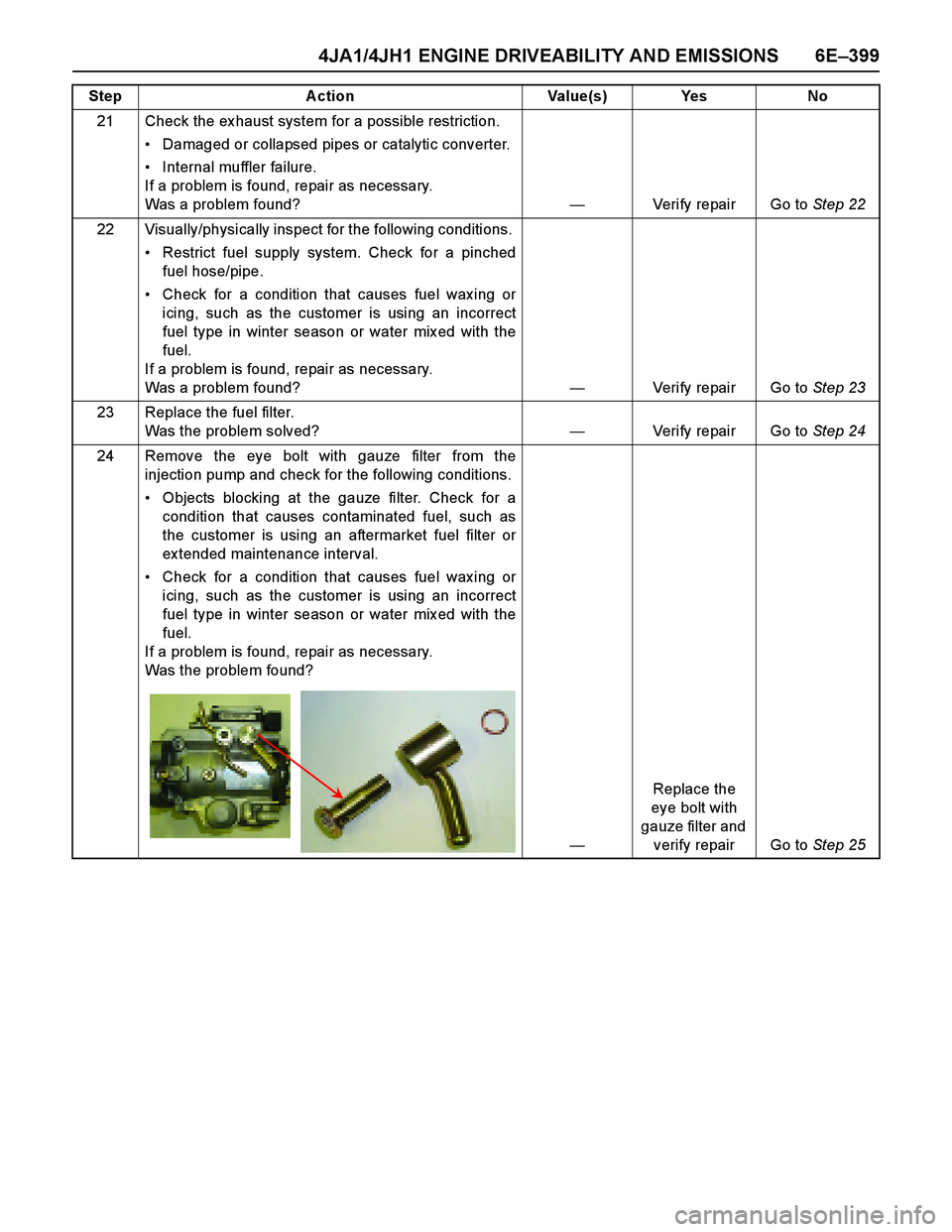
4JA1/4JH1 ENGINE DRIVEABILITY AND EMISSIONS 6E–399
21 Check the ex haust system for a possible restriction.
Damaged or collapsed pipes or catalytic converter.
Internal muffler failure.
If a problem is found, repair as necessary.
Was a problem found?—Verify repair Go to Step 22
22 Visually/physically inspect for the following conditions.
Restrict fuel supply system. Check for a pinched
fuel hose/pipe.
Check for a condition that causes fuel wax ing or
icing, such as the customer is using an incorrect
fuel type in winter season or water mix ed with the
fuel.
If a problem is found, repair as necessary.
Was a problem found?—Verify repair Go to Step 23
23 Replace the fuel filter.
Was the problem solved?—Verify repair Go to Step 24
24 Remove the eye bolt with gauze filter from the
injection pump and check for the following conditions.
Objects blocking at the gauze filter. Check for a
condition that causes contaminated fuel, such as
the customer is using an aftermarket fuel filter or
ex tended maintenance interval.
Check for a condition that causes fuel wax ing or
icing, such as the customer is using an incorrect
fuel type in winter season or water mix ed with the
fuel.
If a problem is found, repair as necessary.
Was the problem found?
—Replace the
eye bolt with
gauze filter and
verify repair Go to Step 25 Step Action Value(s) Yes No
Page 1774 of 4264
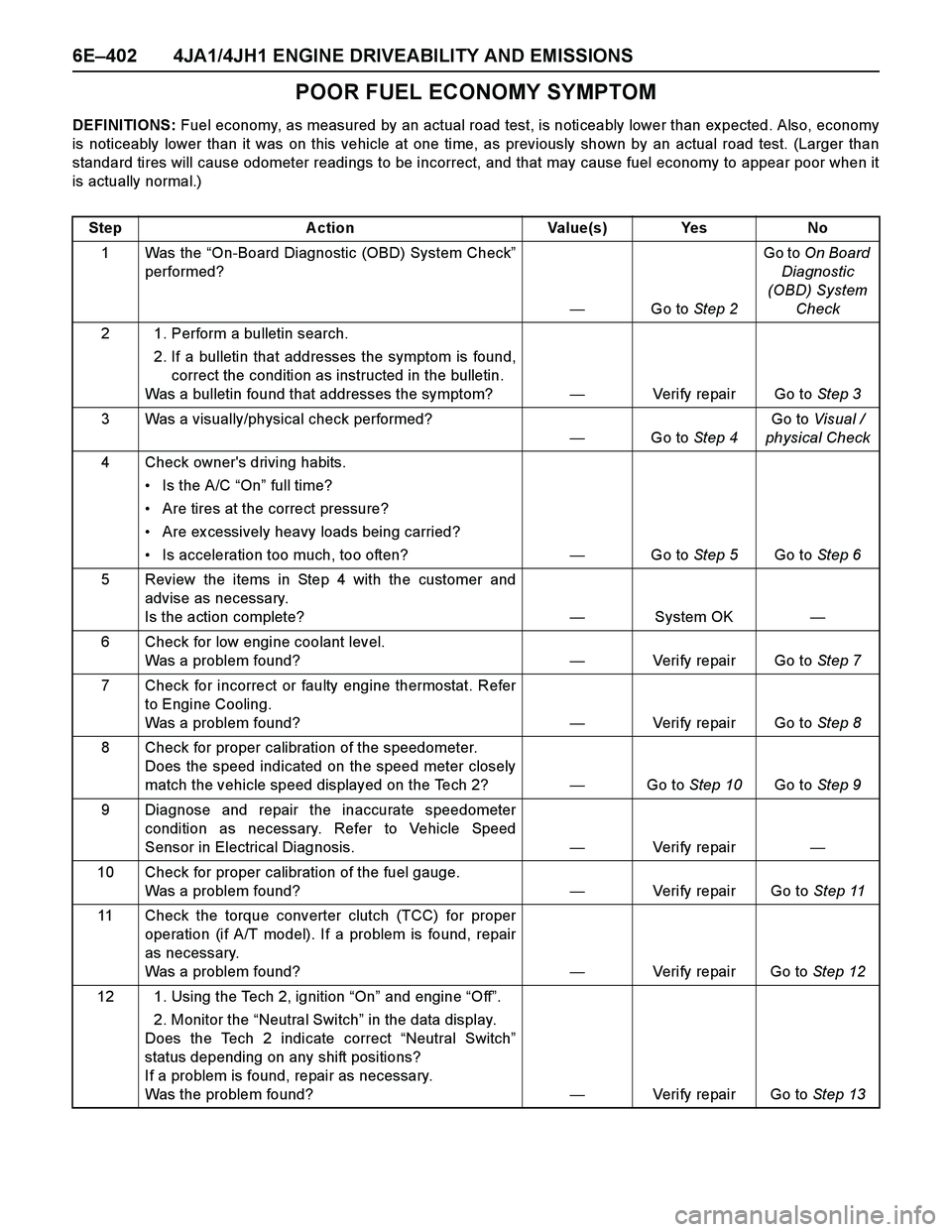
6E–402 4JA1/4JH1 ENGINE DRIVEABILITY AND EMISSIONS
POOR FUEL ECONOMY SYMPTOM
DEFINITIONS: Fuel economy, as measured by an actual road test, is noticeably lower than expected. Also, economy
is noticeably lower than it was on this vehicle at one time, as previously shown by an actual road test. (Larger than
standard tires will cause odometer readings to be incorrect, and that may cause fuel economy to appear poor when it
is actually normal.)
Step Action Value(s) Yes No
1Was the “On-Board Diagnostic (OBD) System Check”
performed?
—Go to Step 2Go to On Board
Diagnostic
(OBD) System
Check
2 1. Perform a bulletin search.
2. If a bulletin that addresses the symptom is found,
correct the condition as instructed in the bulletin.
Was a bulletin found that addresses the symptom?—Verify repair Go to Step 3
3 Was a visually/physical check performed?
—Go to Step 4Go to Visual /
physical Check
4 Check owner's driving habits.
Is the A/C “On” full time?
Are tires at the correct pressure?
Are ex cessively heavy loads being carried?
Is acceleration too much, too often?—Go to Step 5Go to Step 6
5 Review the items in Step 4 with the customer and
advise as necessary.
Is the action complete?—System OK—
6 Check for low engine coolant level.
Was a problem found? —Verify repair Go to Step 7
7 Check for incorrect or faulty engine thermostat. Refer
to Engine Cooling.
Was a problem found?—Verify repair Go to Step 8
8 Check for proper calibration of the speedometer.
Does the speed indicated on the speed meter closely
match the vehicle speed displayed on the Tech 2?—Go to Step 10Go to Step 9
9 Diagnose and repair the inaccurate speedometer
condition as necessary. Refer to Vehicle Speed
Sensor in Electrical Diagnosis.—Veri fy repai r—
10 Check for proper calibration of the fuel gauge.
Was a problem found? —Verify repair Go to Step 11
11 Check the torque converter clutch (TCC) for proper
operation (if A/T model). If a problem is found, repair
as necessary.
Was a problem found?—Verify repair Go to Step 12
12 1. Using the Tech 2, ignition “On” and engine “Off”.
2. Monitor the “Neutral Switch” in the data display.
Does the Tech 2 indicate correct “Neutral Switch”
status depending on any shift positions?
If a problem is found, repair as necessary.
Was the problem found?—Verify repair Go to Step 13
Page 1779 of 4264
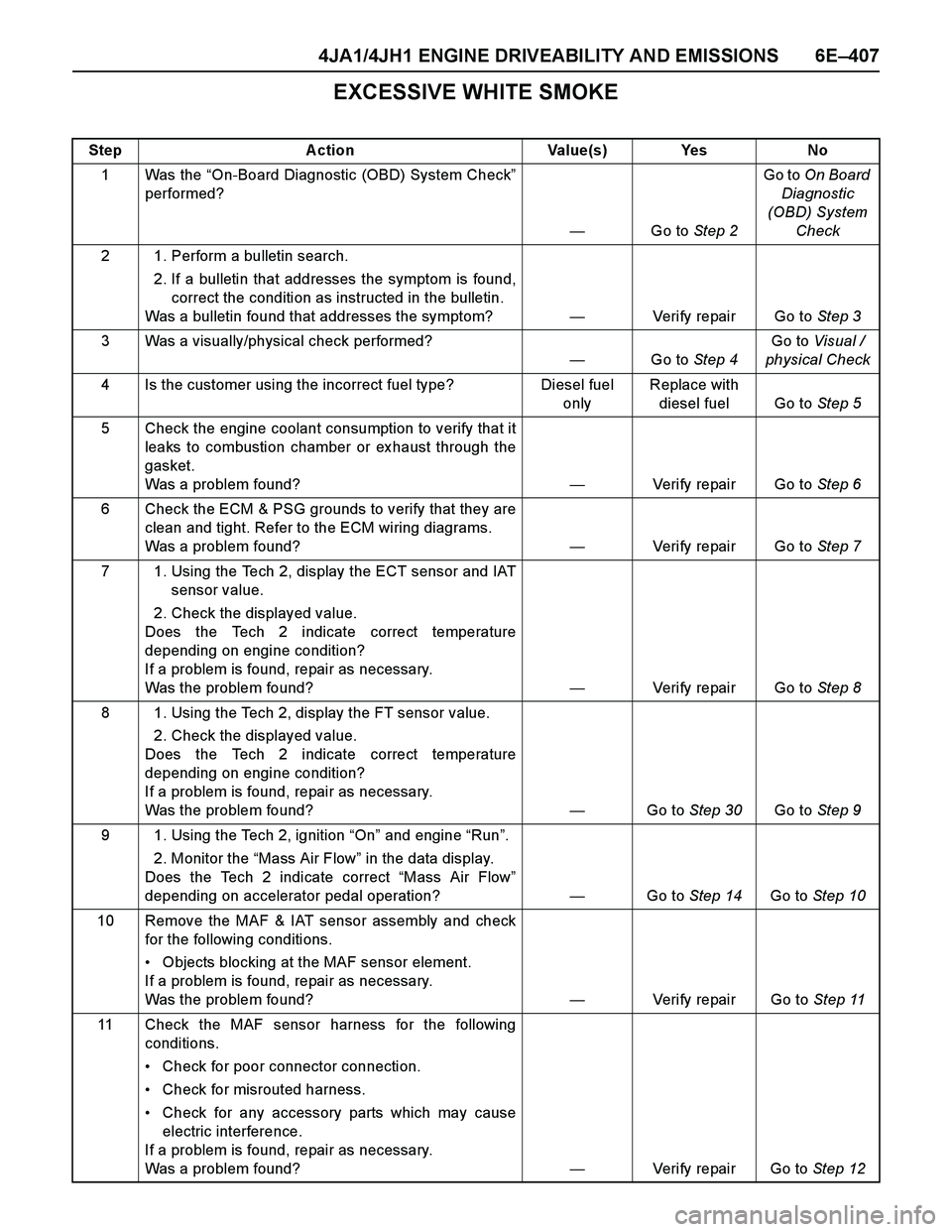
4JA1/4JH1 ENGINE DRIVEABILITY AND EMISSIONS 6E–407
EXCESSIVE WHITE SMOKE
Step Action Value(s) Yes No
1Was the “On-Board Diagnostic (OBD) System Check”
performed?
—Go to Step 2Go to On Board
Diagnostic
(OBD) System
Check
2 1. Perform a bulletin search.
2. If a bulletin that addresses the symptom is found,
correct the condition as instructed in the bulletin.
Was a bulletin found that addresses the symptom?—Verify repair Go to Step 3
3 Was a visually/physical check performed?
—Go to Step 4Go to Visual /
physical Check
4 Is the customer using the incorrect fuel type? Diesel fuel
onlyReplace with
diesel fuel Go to Step 5
5 Check the engine coolant consumption to verify that it
leaks to combustion chamber or ex haust through the
gasket.
Was a problem found?—Verify repair Go to Step 6
6 Check the ECM & PSG grounds to verify that they are
clean and tight. Refer to the ECM wiring diagrams.
Was a problem found?—Verify repair Go to Step 7
7 1. Using the Tech 2, display the ECT sensor and IAT
sensor value.
2. Check the displayed value.
Does the Tech 2 indicate correct temperature
depending on engine condition?
If a problem is found, repair as necessary.
Was the problem found?—Verify repair Go to Step 8
8 1. Using the Tech 2, display the FT sensor value.
2. Check the displayed value.
Does the Tech 2 indicate correct temperature
depending on engine condition?
If a problem is found, repair as necessary.
Was the problem found?—Go to Step 30Go to Step 9
9 1. Using the Tech 2, ignition “On” and engine “Run”.
2. Monitor the “Mass Air Flow” in the data display.
Does the Tech 2 indicate correct “Mass Air Flow”
depending on accelerator pedal operation? —Go to Step 14Go to Step 10
10 Remove the MAF & IAT sensor assembly and check
for the following conditions.
Objects blocking at the MAF sensor element.
If a problem is found, repair as necessary.
Was the problem found?—Verify repair Go to Step 11
11 Check the MAF sensor harness for the following
conditions.
Check for poor connector connection.
Check for misrouted harness.
Check for any accessory parts which may cause
electric interference.
If a problem is found, repair as necessary.
Was a problem found? —Verify repair Go to Step 12
Page 1781 of 4264

4JA1/4JH1 ENGINE DRIVEABILITY AND EMISSIONS 6E–409
19 Substitute a known good CKP sensor and recheck.
Was the problem solved?—Go to Step 20Go to Step 21
20 Replace the CKP sensor.
Is the action complete?—Veri fy repai r—
21 1. Using the Tech 2 and ignition “On” and engine
“Run”.
2. Monitor the following parameters in the data
display.
“Desired Injection Quantity” & “Injection Quantity”
“Desired Injection Start” & “Actual Injection Start”
Are the large gap or unstable parameter displayed
between “Desired” and “Actual”?
—Go to Step 23Go to Step 22
22 Check the ex haust system for a possible restriction.
Damaged or collapsed pipes or catalytic converter.
Internal muffler failure.
If a problem is found, repair as necessary.
Was a problem found?—Verify repair Go to Step 23
23 Visually/physically inspect for the following conditions.
Restrict fuel supply system. Check for a pinched
fuel hose/pipe.
Check for a condition that causes fuel wax ing or
icing, such as the customer is using an incorrect
fuel type in winter season or water mix ed with the
fuel.
If a problem is found, repair as necessary.
Was a problem found?—Verify repair Go to Step 24
24 Replace the fuel filter.
Was the problem solved?—Verify repair Go to Step 25 Step Action Value(s) Yes No
When idling or part-throttle When accelerated
HighDesi red
Low
Ti m e Actu al
High
LowDe si red
Actu al
Time
Page 1782 of 4264
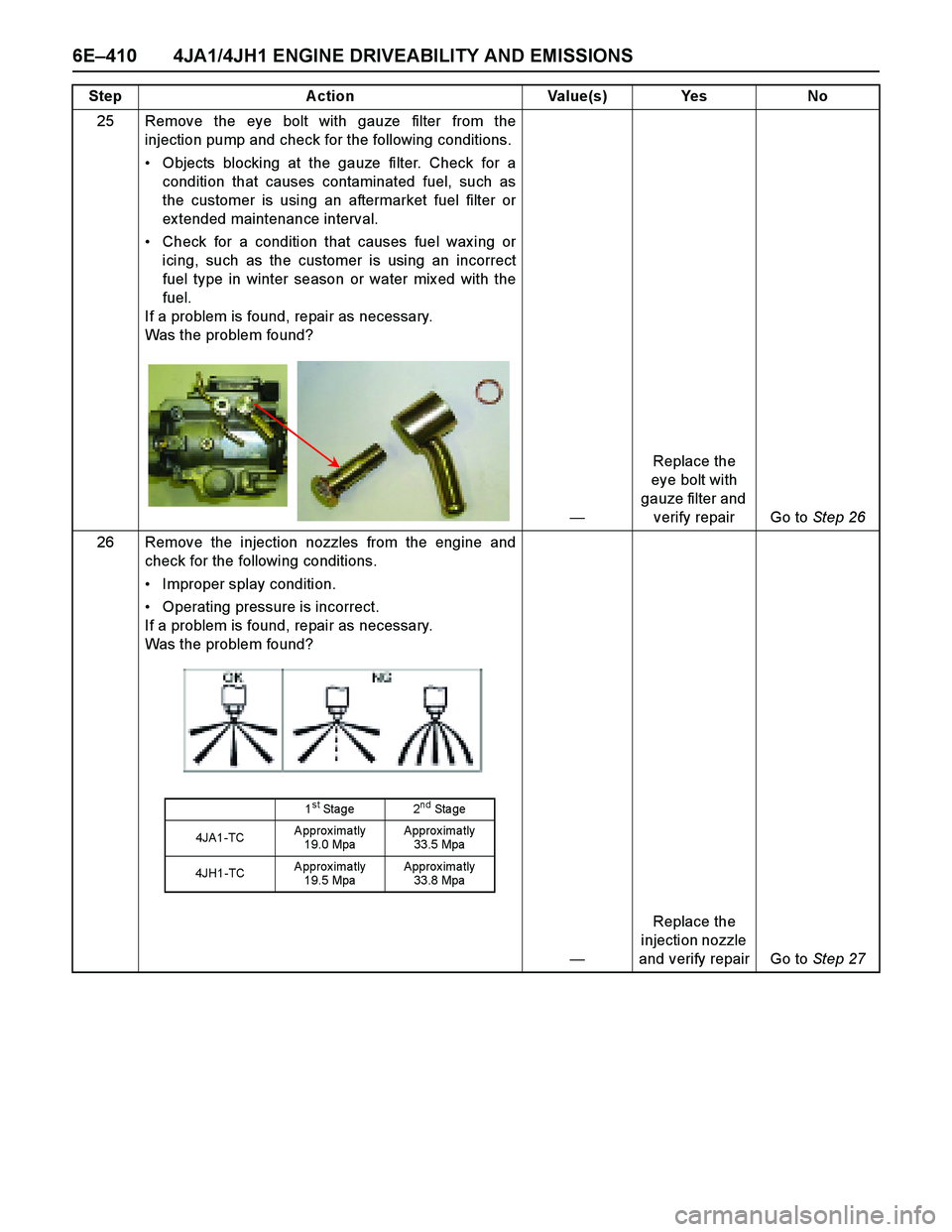
6E–410 4JA1/4JH1 ENGINE DRIVEABILITY AND EMISSIONS
25 Remove the eye bolt with gauze filter from the
injection pump and check for the following conditions.
Objects blocking at the gauze filter. Check for a
condition that causes contaminated fuel, such as
the customer is using an aftermarket fuel filter or
ex tended maintenance interval.
Check for a condition that causes fuel wax ing or
icing, such as the customer is using an incorrect
fuel type in winter season or water mix ed with the
fuel.
If a problem is found, repair as necessary.
Was the problem found?
—Replace the
eye bolt with
gauze filter and
verify repair Go to Step 26
26 Remove the injection nozzles from the engine and
check for the following conditions.
Improper splay condition.
Operating pressure is incorrect.
If a problem is found, repair as necessary.
Was the problem found?
—Replace the
injection nozzle
and verify repair Go to Step 27 Step Action Value(s) Yes No
1st Stage 2nd Sta ge
4JA1-TCApproximatly
19.0 MpaApprox ima tly
33.5 Mpa
4JH1-TCApproximatly
19.5 MpaApprox ima tly
33.8 Mpa